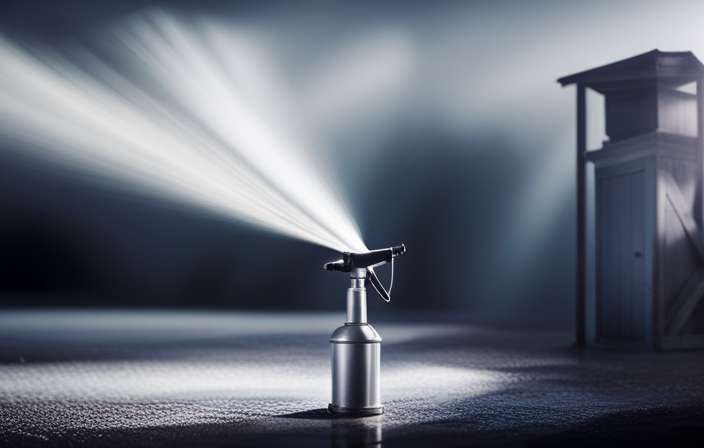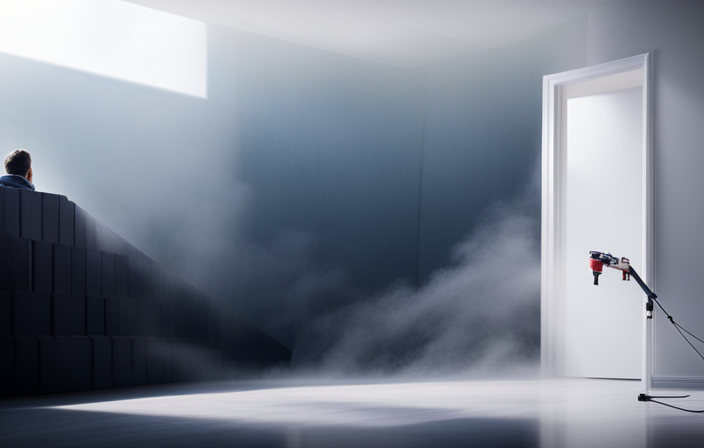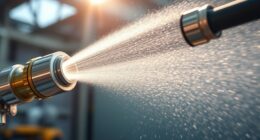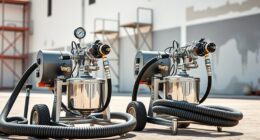Hey there! Are you looking to give your kitchen or bathroom cabinets a new look without breaking the bank? Well, I’ve got the perfect solution for you. Read on to find out more!
In this article, I’m going to show you how to spray paint cabinet doors with an airless sprayer. Trust me, it’s easier than you think!
I know what you’re thinking – painting cabinets sounds like a daunting task. But with the right tools and a little guidance, you’ll be amazed at the transformation you can achieve.
We’ll cover everything from gathering your materials to reattaching the doors, so you’ll have a step-by-step roadmap to follow.
So, if you’re ready to take your cabinets from drab to fab, let’s dive in and get started!
Key Takeaways
- Spray painting cabinet doors with an airless sprayer is a cost-effective way to give kitchen or bathroom cabinets a fresh new look.
- Proper preparation and setup, including protecting the workspace and removing cabinet doors and hardware, are crucial for achieving an even spray paint application.
- Using an airless sprayer requires maintaining a consistent distance, steady hand motion, and troubleshooting common spraying issues for a professional finish.
- Applying multiple thin coats of paint, allowing each coat to dry before applying the next, and ensuring proper drying and curing time are essential for a durable and long-lasting result.
Gather Your Materials and Prepare Your Workspace
Now that you’ve got all your materials ready and your workspace prepped, it’s time to dive into the exciting world of spray painting your cabinet doors with an airless sprayer!
When choosing the right spray paint color for your cabinet doors, consider the overall aesthetic of your kitchen or the desired style you want to achieve. Neutral colors like white or gray are always a safe bet, but don’t be afraid to go bold with a pop of color if you want to make a statement.
Before you start spraying, it’s important to protect your workspace from overspray. Cover countertops, floors, and surrounding areas with drop cloths or plastic sheets to prevent any paint from getting where it shouldn’t.
Now that your color is chosen and your workspace is protected, it’s time to move on to the next step: removing the cabinet doors and hardware.
Remove Cabinet Doors and Hardware
First, it’s time to bid farewell to your cabinet doors and their accompanying hardware, giving them a temporary vacation from their daily duties. Start by removing all the hardware from the doors, such as handles, knobs, and hinges. This will ensure that you can spray paint the doors evenly without any obstructions.
Next, carefully detach the cabinet doors from their frames using a screwdriver or drill. Place them in a safe, clean area where they won’t get damaged. As you remove the doors, take note of their original position so you can easily reinstall them later.
Additionally, take this opportunity to prepare your workspace by covering any nearby furniture or surfaces with drop cloths or plastic sheets to protect them from overspray.
Now that your cabinet doors and hardware are safely stored away and your workspace is prepped, it’s time to move on to the next step: cleaning and sanding the cabinet doors.
Clean and Sand the Cabinet Doors
Get ready to transform your tired and worn-out cabinet doors into beautiful works of art by giving them a thorough cleaning and sanding. Properly cleaning and sanding the cabinet doors is crucial for achieving a smooth and professional finish. Start by removing any hardware and laying the doors flat on a clean workspace. Using a bucket of warm water and mild detergent, wipe down the doors to remove any grease or dirt. Once they are clean and dry, use a fine-grit sandpaper to gently sand the surface, going with the grain of the wood. This will create a rough texture that helps the primer adhere better. Speaking of primer, choosing the right one is essential. Look for a primer specifically designed for use on cabinets, as it will provide better adhesion and durability. Apply the primer using smooth, even strokes, and let it dry completely before moving on to the next step of spraying on the paint.
Apply Primer to the Cabinet Doors
To achieve a smooth and professional finish, it’s important to apply a primer specifically designed for cabinets to the freshly cleaned and sanded cabinet doors.
When it comes to priming techniques, there are a few things to consider. First, make sure to choose the right primer for your project. Look for a primer that’s compatible with the type of paint you plan to use and offers good adhesion to the cabinet surface. Additionally, opt for a primer that has good coverage and dries quickly to save you time.
When applying the primer, use smooth and even strokes, moving in the same direction as the wood grain. This’ll help ensure an even coat and minimize brush or roller marks.
Once the primer is dry, you can move on to the next step of setting up your airless sprayer and testing the spray pattern.
Set Up Your Airless Sprayer and Test Spray
Once you have all your tools and materials ready, step into the world of transforming your cabinets by setting up your powerful, high-tech painting machine and experiencing the excitement of testing the smooth, even spray that will bring your cabinets to life.
| Common Issues | Troubleshooting |
|---|---|
| Uneven spray | Adjust pressure |
| Clogging | Clean nozzle |
| Drips | Check viscosity |
| Overspray | Adjust nozzle |
| Dry patches | Increase pressure |
Before you start spraying the cabinet doors, it’s important to test the pressure of your airless sprayer. Adjust the pressure according to the manufacturer’s instructions to ensure an even and controlled spray. Troubleshoot common issues such as uneven spray, clogging, drips, overspray, and dry patches. By testing the spray and addressing any issues, you’ll be able to achieve professional results. Now that you’ve set up your sprayer and tested the spray, it’s time to move on to the next step of spraying the cabinet doors.
Start Spraying the Cabinet Doors
After setting up your airless sprayer and conducting a test spray to ensure everything’s working properly, it’s time to start spraying the cabinet doors.
Here are some tips for achieving a flawless finish and troubleshooting common spraying issues. First, make sure to maintain a consistent distance between the sprayer and the doors, usually around 8-12 inches. This helps to avoid uneven coverage and drips.
Additionally, keep your hand steady and move in a smooth, controlled motion to ensure an even application. If you notice any areas with excessive paint buildup or drips, quickly smooth them out with a brush or roller before they dry.
Finally, always spray in a well-ventilated area and wear a mask for personal protection. With these tips in mind, you’ll be well on your way to a professional-looking finish.
Now, let’s move on to applying multiple coats for a smooth finish.
Apply Multiple Coats for a Smooth Finish
For a flawless finish, you’ll want to apply multiple coats, ensuring a smooth and professional look. Start by applying thin coats of paint to the cabinet doors, using smooth and even strokes with your airless sprayer. This will help prevent drips and uneven coverage.
As you apply each coat, make sure to overlap your strokes slightly to ensure complete coverage. Take your time and allow each coat to dry before applying the next one. This will help prevent any smudging or streaking.
For a professional finish, it’s also important to maintain a consistent distance from the surface and move the sprayer at a steady pace. By following these tips and applying multiple thin coats, you’ll achieve a smooth and professional finish.
Now, let the paint dry and cure before moving on to the next step.
Allow the Paint to Dry and Cure
Let the paint work its magic as it dries and cures, transforming your cabinets into a stunning masterpiece. After applying the final coat of paint, it’s important to allow sufficient drying time before handling or reattaching the cabinet doors.
The drying time can vary depending on factors such as temperature and humidity, so it’s best to refer to the paint manufacturer’s instructions for specific guidelines. Typically, it takes around 24 to 48 hours for the paint to dry completely.
Once the paint is dry, it will go through a curing process, which can take up to a week or longer. During this time, the paint will harden and reach its maximum durability.
Once the paint has dried and cured, you can move on to reattaching the cabinet doors and hardware, bringing your project to its final stage.
Reattach Cabinet Doors and Hardware
Now it’s time to bring your cabinets back to life by reattaching the doors and adding the finishing touches with your chosen hardware. Reattaching cabinet doors securely is crucial to ensure they function properly and look seamless. Begin by aligning the hinges on the door with the corresponding holes on the cabinet frame. Use a screwdriver to tighten the screws and secure the doors in place. Once the doors are reattached, it’s time to choose the right hardware. Consider the style and finish of your cabinets when selecting handles or knobs. A 2 column and 4 row table can help you visualize the options. Remember to measure the hole spacing accurately to find hardware that fits perfectly. With the doors securely reattached and the hardware installed, you can now move on to the next step and enjoy your newly painted cabinet doors.
Enjoy Your Newly Painted Cabinet Doors
After all your hard work, you can finally kick back and enjoy the fresh new look of your cabinets. Imagine walking into your kitchen and being greeted by beautifully painted cabinet doors that perfectly complement the rest of your decor.
Here’s how you can enjoy your newly painted cabinet doors:
-
Choose the right paint color: Consider the overall style and color scheme of your kitchen. Opt for a color that harmonizes with the rest of the room and reflects your personal taste.
-
Properly clean and maintain painted cabinet doors: Use a gentle cleaner or mild soap to clean the doors regularly, avoiding harsh chemicals that can damage the paint. Wipe away any spills or stains immediately to prevent them from setting in.
-
Avoid excessive moisture: Be mindful of steam from cooking or hot water, as prolonged exposure can cause the paint to peel or bubble. Use ventilation to minimize moisture buildup.
-
Handle with care: Avoid slamming or scratching the doors, and use soft-close mechanisms if possible. Regularly inspect and tighten any loose hardware to ensure longevity.
By following these tips, you can enjoy your newly painted cabinet doors for years to come.
Frequently Asked Questions
Can I use a regular paint sprayer instead of an airless sprayer for this project?
Using a regular paint sprayer instead of an airless sprayer for cabinet doors has pros and cons. Pros include ease of use and portability, but cons include potential for uneven coverage. Recommended techniques include thinning the paint and using a fine finish tip.
How long should I wait between applying coats of primer and paint?
I typically wait for the primer to dry completely before applying the paint. The drying time can vary depending on the product, so it’s best to follow the manufacturer’s instructions. It’s recommended to apply multiple coats of paint for a smooth, even finish.
Do I need to remove the cabinet doors from the hinges to spray paint them?
Removing cabinets for spray painting is like trying to catch a wild squirrel with chopsticks. It’s unnecessary and a major hassle. Instead, learn the right spray painting techniques to achieve professional results without removing the cabinet doors from the hinges.
Can I spray paint over existing paint on the cabinet doors?
Yes, you can spray paint over existing paint on cabinet doors. However, it’s important to properly prepare the surface by cleaning and sanding it. Applying a primer before spraying can also help achieve a smooth finish.
What type of paint should I use for the best results when spray painting cabinet doors?
For the best results when spray painting cabinet doors, I recommend using high-quality paint brands like Sherwin-Williams or Benjamin Moore. These brands offer excellent coverage and durability. Additionally, using proper spray painting techniques such as even strokes and overlapping passes will ensure a smooth and professional finish.
Conclusion
Well, there you have it! I’ve just walked you through the process of spray painting your cabinet doors with an airless sprayer. It may seem like a daunting task, but with the right materials and a little bit of elbow grease, you can achieve a professional-looking finish.
Remember, practice makes perfect, so don’t be afraid to test spray and apply multiple coats. Once everything is dry and cured, you’ll be able to sit back and admire your handiwork.
So go ahead, give your kitchen a fresh new look and watch those cabinet doors shine like a diamond in the rough.










